I practically killed myself getting this finished before I left on my trip, but here it is.

I am constantly scouring thrift stores and Goodwill for old wool or cashmere sweaters. If they won’t fit any of my family, into the wash they for felting. Sometimes it takes 2 or 3 trips through the wash to get them felted really well. Once a sweater is felted, you can cut it without worry that it will unravel on you. This works best with only 100% (or pretty close to it) wool or cashmere. I’ve got boxes of sweaters that I’ve bought at thrift stores, some felted and some not, waiting for the time to make all of the projects I’ve got in mind.
I wanted to make a quilted blanket with smaller pieces of some of these sweaters. I found this great pinwale corduroy recently, and my sister and I came up with a good color scheme to go with it. Using mostly the arms of sweaters, saving the larger body pieces for other projects, I cut the sweaters into 6″ squares using a cutting mat and a rotary cutter. If I had some smaller pieces, I made a few that were 3-1/4″ x 6″ and patched two pieces together to make a square just for something a little different in the quilt.

6" squares of felted sweaters.
I’m extremely fortunate to have a sewing machine called an overlock. I’ve been wanting it for years and finally got it for Christmas last year. However, if you don’t happen to have one of these, I think this project is still possible. If the sweaters are properly felted, unraveling shouldn’t be a concern. You can either stitch the pieces together using a large zigzag stitch, or you can just seam them together with a sewing machine. For demonstration purposes though, I’ll show you how I did it with my overlock.
I laid out the general pattern I wanted on a large clean surface. I was careful to lay them out in alternating directions so that the weave switched from diagonal to horizontal every other strip. This should help to keep the blanket from stretching out. I was also careful not to have the same pattern next to each other; no two cables butted up next to each other in the same strip. Then I sewed together one strip at a time, overlapping two squares and joining them. I was careful to always keep the seams going in the same direction.

Lay out the general pattern/color scheme you'd like on a large, clean surface.

Stitch two 6" squares together, with one piece slightly overlapping the other.
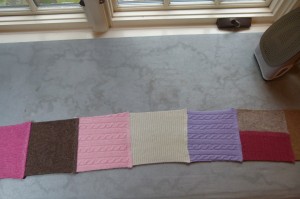
A finished strip of sweater pieces.

Sewing the fabrics together may cause a little stretching, so straighten out any uneven edges with a straight-edge and your rotary cutter.
Lay out all the strips together to give your design a final once-over. Make sure all the colors in each strip work with the strip they’ll be joined with. Some juggling may be necessary. Then, again keeping the seams all going in the same direction, I joined the strips together, one at a time, to make the quilt.
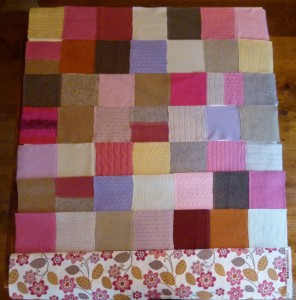
Lay out the strips together, making sure all the colors are working with colors in the next strip. Some juggling may be necessary.
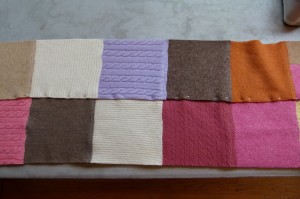
Pen the strips together, overlapping one strip slightly with the other.
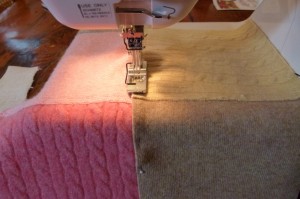
Sew the strips together.
Continue sewing the strips together until you’ve got the top of your quilt completed.
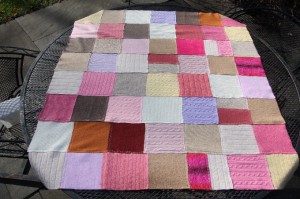
The finished sweater quilt top

This is what the backside looks like when it's done with an overlock machine.
Then I joined the top with the corduroy fabric, and I used wool batting in between. I used this batting on Sia’s Baby Blanket and really loved it.

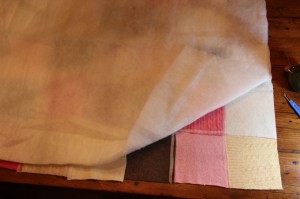
Cut batting slightly smaller than the sweater quilt top.

 Turn the quilt right side out.
Turn the quilt right side out.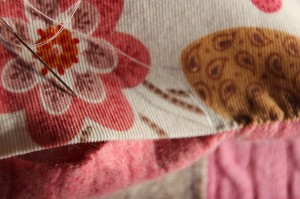
I used a fairly thin yarn and made french knots at each square to join the quilt and prevent any shifting of the batting. I made a knot in the doubled yarn on a needle and came down through the top at the “intersection” points. Come right back up with the thread to the top, being careful that you get right at that intersection point again. wrap the thread around the needle a few times, and holding the thread taught, came down close to the same point that you’re already gone through at the bottom. Pull the thread gently, still holding the thread taught, and you’ll form a french knot! Click here for a good tutorial on what I’m trying to explain. You want a really big knot, so do wrap the yarn around the needle 3 or 4 times! At the back, stitch around the threads already there once or twice, then make a knot and snip the yarn, leaving about 1/3″.

French knots at the corners throughout the quilt.
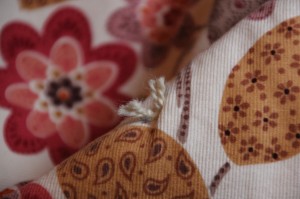

I love the way it came out. It’s a great project, and would make a great baby gift, or Christmas gift. Mine measures 40″ x 43″ finished, but you can make it any size you want. Let me know if you try it, or if you have any questions about how I made this one. Pin It
I love anything made with recycled sweaters (those bracelets you did, scarves, etc.) so this is right up my alley. I have a blanket where the background is all squares of dark navy/blue as the “sky” and then there are white sweater stars appliqued on. Trimmed in velvet. I will show you sometime; am sure you would find a way to improve on it! Love that the beekman wreath has a sweater bow that you can use as a scarf after the holidays are over. so many great uses for felted wool/cashmere. Thanks for sharing this beauty.
That’s a genuinely imresspive answer.